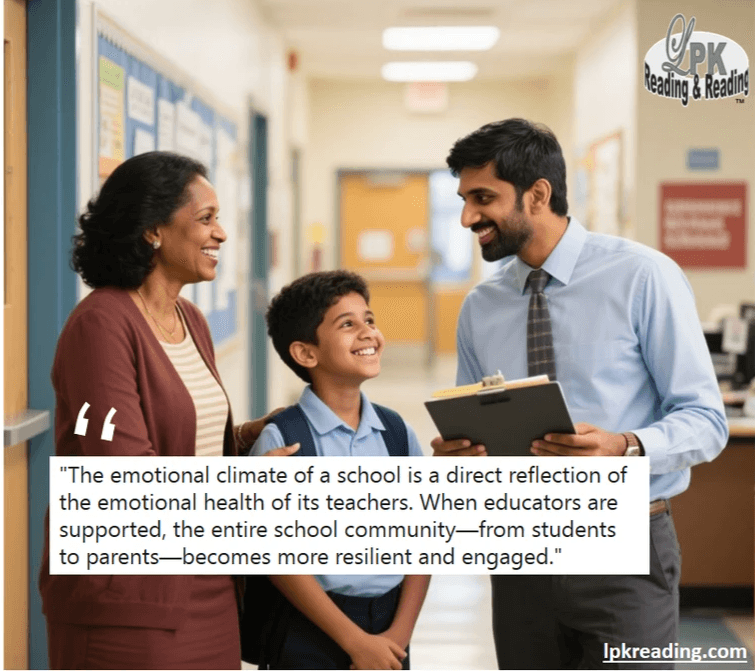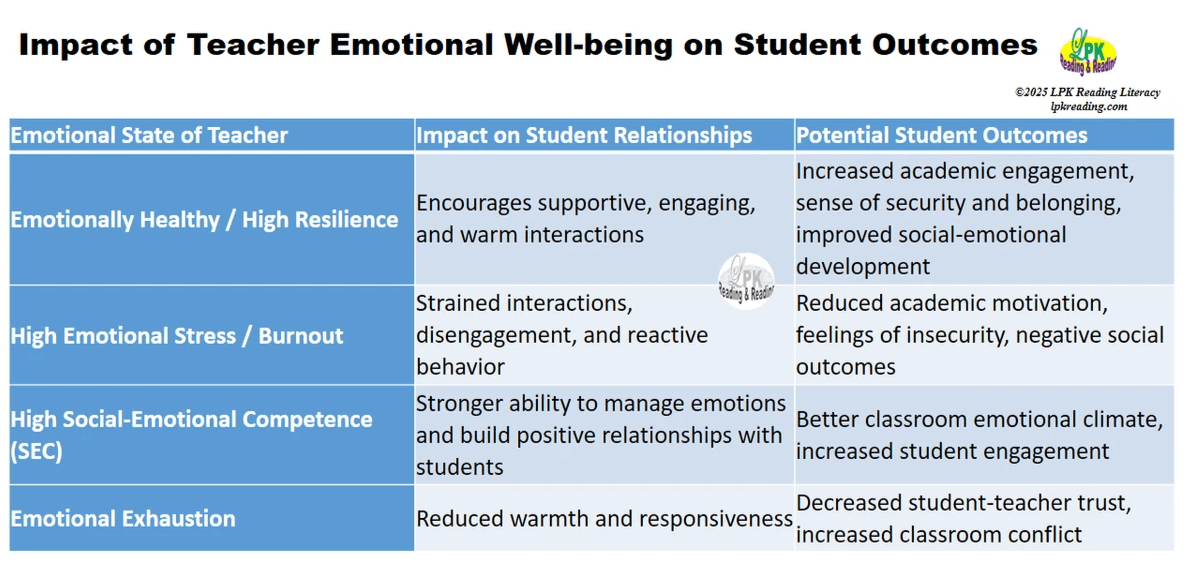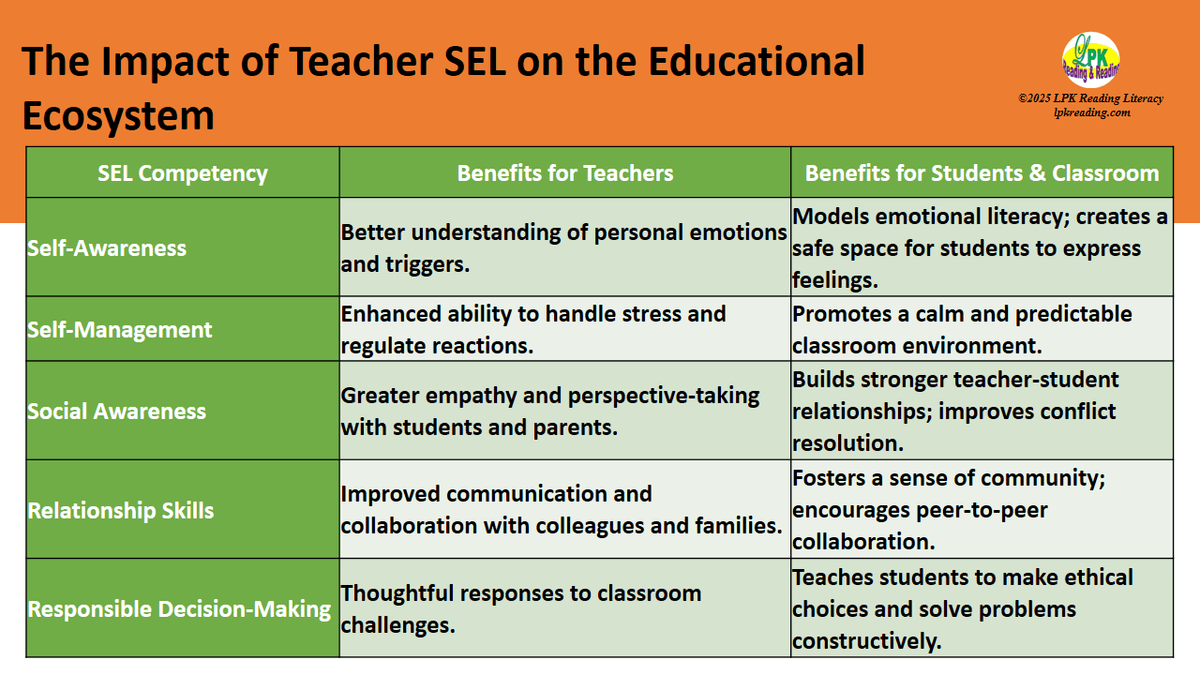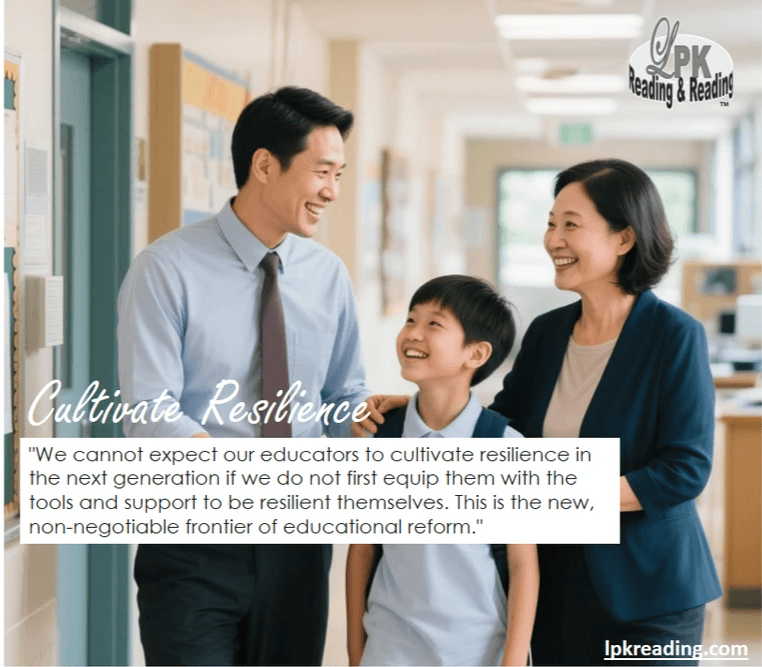What if we told you that student success isn't only in the curriculum, but in the person delivering it? While we relentlessly measure academic performance, we've overlooked the hidden force shaping our classrooms: the emotional well-being of our teachers. What happens when the people entrusted with our children's future are emotionally depleted? The answer has a profound impact on every student, every parent, and the very foundation of our educational system.
The Hidden Impact of Teacher Emotional Well-being on Student Relationships and Parent Engagement

Abstract
This article explores the often-overlooked connection between teacher emotional well-being and the quality of relationships with students and parents. Grounded in research on teacher burnout, emotional labor, professional evaluations, and social-emotional learning (SEL), the article examines how teacher emotional health influences student-teacher interactions and parent-teacher engagement. The findings underscore that teacher emotional well-being is a crucial factor in fostering positive academic and social outcomes for students. The article concludes with recommendations for supporting teacher well-being as a means of strengthening educational environments.
Introduction
The discourse on education often emphasizes academic achievement, curriculum effectiveness, and student performance. However, the emotional well-being of teachers—arguably one of the most significant factors in the learning environment—is frequently neglected. Teachers navigate significant emotional labor daily, managing classroom dynamics, administrative expectations, and personal challenges. Research suggests that teacher emotional well-being plays a pivotal role in shaping student-teacher relationships and parent engagement. This article explores evidence-based insights into how teacher emotional health influences these dynamics, affecting students' social-emotional development and academic success.

Studies indicate that emotionally healthy teachers create more supportive and engaging learning environments (Jennings & Greenberg, 2009). Teachers experiencing high emotional stress or burn out are more likely to exhibit disengagement or reactive behavior in the classroom, negatively impacting student relationships. Research by Spilt, Koomen, and Thijs (2011) found that teacher emotional exhaustion correlates with strained student-teacher interactions, reducing warmth and responsiveness. Conversely, teachers with high emotional resilience foster a sense of security and belonging, contributing to positive student outcomes.
The Role of Emotional Labor in Teaching
Teaching is an emotionally demanding profession that requires educators to regulate their feelings while maintaining a supportive learning environment. As noted by Hochschild (1983), teachers frequently engage in emotional labor, often suppressing negative emotions to maintain a professional demeanor. However, without adequate support, this sustained emotional suppression can lead to emotional depletion, hindering effective instruction and trust with students. Research indicates that professional development focused on emotional self-regulation can help teachers more effectively manage classroom stress (Brackett et al., 2010).
An educator's emotional well-being directly impacts the quality of their student relationships. Teachers with high social-emotional competence (SEC)—which includes skills such as self-awareness, self-regulation, and empathy—are better equipped to build positive connections with students. When a teacher's emotional health is compromised, they may exhibit behaviors like impatience, criticism, or disengagement, creating a negative cycle where their stress strains student relationships and further increases their emotional burden.
Studies have consistently shown that emotionally healthy teachers foster more supportive and engaging classrooms, while those experiencing burnout are more likely to have strained interactions with students. This emotional exhaustion can reduce a teacher's warmth and responsiveness, directly affecting instructional effectiveness and a student's sense of security. Ultimately, a teacher's emotional resilience is foundational to creating a classroom environment where students feel safe and supported, which is essential for both academic and social-emotional growth.

Teacher Well-being and Parent Engagementt
Parental involvement is a cornerstone of student success, yet it heavily depends on the quality of parent-teacher relationships. Research by Joyce Epstein (2011) emphasizes that when teachers feel supported and valued, they engage more positively with parents, fostering trust and collaboration. link: Joyce Epstein's School-Family-Community Partnership Model Teachers experiencing burnout may struggle with effective communication, leading to disengaged or adversarial parent-teacher interactions. Studies show that when teachers receive emotional well-being support, parent-teacher relationships improve, enhancing student learning experiences (Yoon, 2002). link: Influence of Teacher Support and Parent Support on Academic Achievement
The Impact of Professional Evaluations on Teacher Motivation
Performance evaluations influence teacher motivation and emotional health. A study by Kraft and Gilmour (2016) found that high-stakes evaluations can contribute to stress and burnout, negatively affecting teacher efficacy and relationships with students and parents.
Conversely, supportive, formative evaluations that focus on growth rather than punitive measures can enhance teacher well-being and effectiveness (Taylor & Tyler, 2012).
Social-Emotional Learning (SEL) forTeachers
Incorporating Social-Emotional Learning (SEL) programs for teachers is a crucial intervention for their emotional well-being and professional growth. This approach recognizes that effective teaching is not only about pedagogical skill but also about emotional intelligence and resilience. The core competencies of SEL—self-awareness, self-management, social awareness, relationship skills, and responsible decision-making—are particularly vital for educators who navigate emotionally demanding environments.
Research by Jennings and Greenberg (2009) and the Collaborative for Academic, Social, and Emotional Learning highlights that when teachers are equipped with SEL skills, they are better able to manage stress, avoid burnout, and form more meaningful relationships with students and parents. This directly counters the negative effects of high-stakes evaluations and emotional labor. SEL training helps teachers develop an empathetic mindset, which is foundational for creating a supportive and inclusive classroom culture. When teachers model these skills, it not only improves their own well-being but also fosters a positive feedback loop, where a calm and regulated teacher leads to a calm and regulated classroom. This, in turn, can significantly enhance student engagement and academic outcomes.

Furthermore, a study by Jennings, Frank, Snowberg, Coccia, and Greenberg (2013) found that SEL training not only enhances teachers’ ability to manage emotions and improve relationships but also develops a positive classroom environment. When teachers receive SEL support, students also benefit from an improved emotional climate, leading to better academic performance. The benefits are systemic, extending from the individual teacher to the entire school community.
The Unseen Ripple Effect of Teacher Well-being
The profound impact of a teacher's emotional health resonates far beyond their classroom. Their ability to manage their own emotions directly influences a student's academic motivation, self-esteem, and social-emotional development. Furthermore, emotionally stable and engaged teachers are pivotal in building strong school-community partnerships, which are essential for creating a collaborative and supportive educational environment for all.
Addressing the Gap in Support
Despite strong evidence linking teacher well-being to student and parent engagement, many educational systems fail to prioritize emotional health interventions. Teacher burnout rates remain alarmingly high, and professional development often neglects crucial emotional self-care. However, schools that implement robust well-being programs see significant improvements in teacher retention, student outcomes, and parental involvement (Schonert-Reichl, 2017).
Conclusion and Recommendations

To cultivate healthier educational environments, schools and policymakers must acknowledge and address teacher emotional well-being as a foundational priority.
Integrating SEL Training for Teachers: Providing educators with emotional resilience training to enhance their self-regulation and classroom management skills.
Supportive Professional Evaluations: Shifting from punitive performance assessments to formative, growth-oriented feedback models that support professional development.
Well-being Programs and Resources: Establishing accessible mental health resources, peer-support groups, and counseling services for teachers.
Workload Management and Institutional Support: Reducing administrative burdens and encouraging a school-wide culture of appreciation and collaboration.
Encouraging Stronger Parent-Teacher Partnerships: Training teachers in effective communication strategies to build stronger parental engagement.
Ultimately, addressing teacher emotional well-being isn't a secondary concern—it's foundational to student success and school effectiveness. By investing in the well-being of our educators, we cultivate a more engaged, resilient, and thriving educational community.
References
Brackett, M. A., Palomera, R., Mojsa-Kaja, J., Reyes, M. R., & Salovey, P. (2010). Emotion-regulation ability, burnout, and job satisfaction among British secondary-school teachers. Psychology in the Schools, 47(4), 406-417.
Epstein, J. L. (2011). School, family, and community partnerships: Preparing educators and improving schools. Routledge.
Hargreaves, A. (2001). Emotional geographies of teaching. Teachers College Record, 103(6), 1056-1080.
Hochschild, A. R. (1983). The managed heart: Commercialization of human feeling. University of California Press.
Jennings, P. A., & Greenberg, M. T. (2009). The prosocial classroom: Teacher social and emotional competence in relation to student and classroom outcomes. Review of Educational Research, 79(1), 491-525.
Kraft, M. A., & Gilmour, A. F. (2016). Revisiting the widget effect: Teacher evaluation reforms and the distribution of teacher effectiveness. Educational Researcher, 45(5), 234-252.
Schonert-Reichl, K. A. (2017). Social and emotional learning and teachers. The Future of Children, 27(1), 137-155.
Spilt, J. L., Koomen, H. M. Y., & Thijs, J. T. (2011). Teacher well-being: The importance of teacher-student relationships. Educational Psychology Review, 23(4), 457-477.
Taylor, E. S., & Tyler, J. H. (2012). The effect of evaluation on teacher performance. American Economic Review, 102(7), 3628-3651.
Yoon, J. S. (2002). Teacher characteristics as predictors of teacher-student relationships: Stress, negative affect, and self-efficacy. Social Behavior and Personality, 30(5), 485-493.

